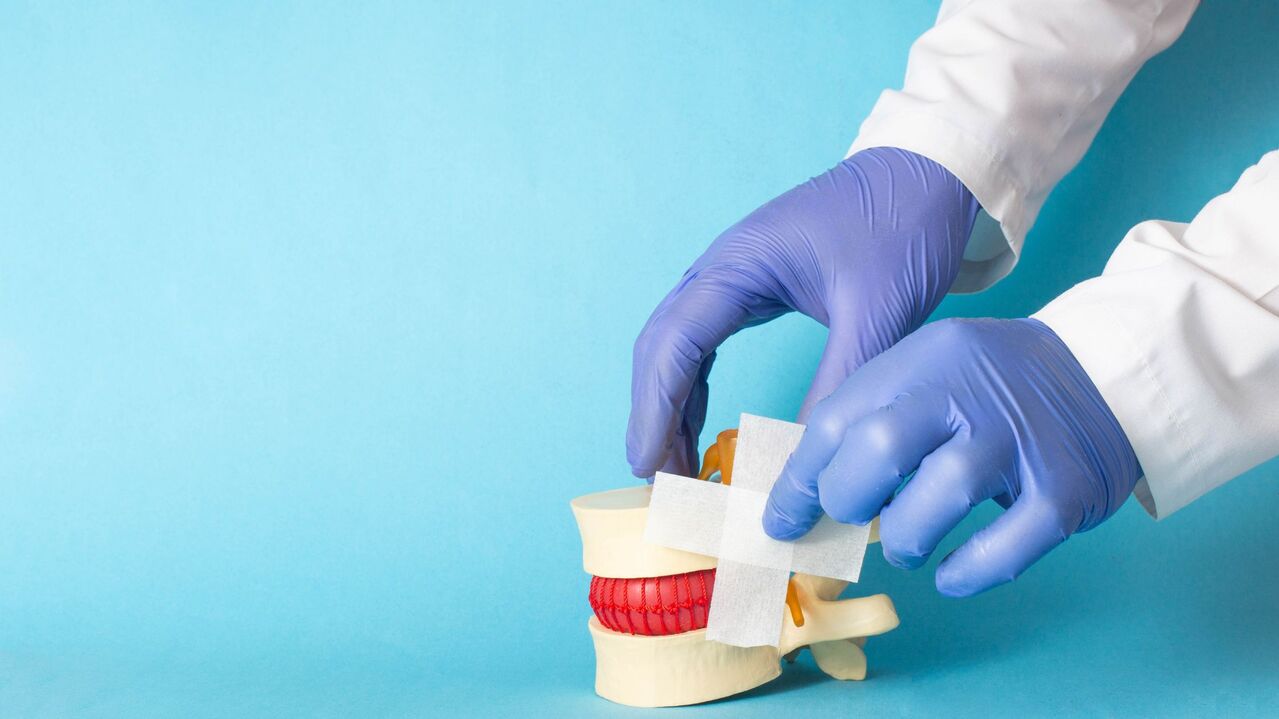Osteochondrosis is a long-term disease. Often, when assessing the severity of pathological processes, four stages are distinguished:
- The first stage is the period of initial changes occurring in the fibrous ring of the disc, which often does not escape the attention of the patient;
- The second stage corresponds to the appearance of instability in the affected segment of the spine, a decrease in the height of the disc;
- The third stage is characterized by the appearance of tears or osteochondral growths - osteophytes, at this stage the fibrous ring is almost destroyed;
- The fourth stage is characterized by irreversible damage to all structures that ensure intervertebral articulation, disc fibrosis and loss of mobility in the affected segment.

Causes of osteochondrosis of the thoracic region
It has been shown that from around the age of 20, our vertebrae begin to slowly deteriorate. With age, wear and tear on the spine progresses. Due to degenerative processes, there is a decrease in the thickness of the intervertebral disc, which acts as a shock absorber. In addition, abnormal structures appear on the bone edges of adjacent vertebrae: bone rods, spondylophytes, which reduce the range of motion.
Degenerative-dystrophic changes start from the nucleus pulposus, then spread to the annulus fibrosus, as well as other structural elements of the vertebra, causing the appearance of characteristic symptoms.
Due to water loss, the nucleus pulposus stops evenly distributing the vertical load. This has a negative effect on the fibrous ring. Excessive compression (compression) causes its mechanical damage, the appearance of breaks and cracks. The joints begin to experience excessive stress, which gradually leads to instability of the spine and pain.
Thus, the main cause of osteochondrosis is natural aging. However, its development is facilitated by the combination of many unfavorable factors that increase the probability of the disease. These include:
- To smoke;
- He performed spinal surgeries;
- Damage to this part of the spine;
- Curvature of the spine (scoliosis);
- Weakness of back muscles;
- Excessive body weight;
- Increased load on the spine.
It is believed that the involution (aging) of the cartilage and bone tissue of the vertebrae is determined genetically, and the transition to the disease state with characteristic symptoms and manifestations occurs under the influence of external and internal factors. If the processes precede the injury (mechanical, inflammatory, etc. ), it can start earlier.
Symptoms of osteochondrosis of the thoracic region
Symptoms of osteochondrosis of the thoracic spine will depend on the stage of the pathological process and existing structural disorders. Unlike other areas of the spine (cervical, lumbar), radicular syndrome and other neurological complications are less characteristic of the thoracic region. This is explained by the presence of the thoracic bone frame, which limits the displacement and compression of this part of the spine. Often, pain in the thoracic region (dorsalgia or thoracic lumbago) is associated with immobilization of the intervertebral joints.
Reference! Thoracic lumbago or dorsago, in neurology, refers to acute pain in the thoracic spine, often accompanied by difficulty breathing. The cause of the condition lies in the severe spasm of the back muscles. This cannot be ignored because. . . Myocardial infarction can start in the same way, and often lumbago can be associated with serious pathologies in the body.
The pain can last from a few hours to a few days. As a rule, it is not as intense as damage to other parts of the spine, but is also associated with the movement of the spine. In addition, muscle hypertonicity is detected in this area, which can be combined with weakness and numbness in the hands.
Pain can be dull, burning, deep, paroxysmal or constant. It can be felt in the chest, heart and other organs. Patients describe it as a "stake in the chest", "squeezing the chest with a ring", "a stab between the shoulder blades". This section is characterized by deep sighing, coughing, and radiating and girdle pain associated with sudden movements of the chest.
Without treatment, osteochondrosis of the thoracic spine is often complicated by intercostal neuralgia. In this case, the burning pain may be localized in the heart region and may be mistaken by the patient for manifestations of cardiac pathology.

It is important! If you feel pain in the heart area, you should not try to make a differential diagnosis on your own. In order to exclude heart diseases and prevent the development of pathological processes in the spine, it is important not to delay consulting a doctor, not to wait for pain and not to self-medicate.
Pain can increase with physical activity, bending and psycho-emotional stress. When the extreme vertebrae of this region are affected, the pain can spread to the lower back, sacrum, and even the hips.
Diagnosis of osteochondrosis of the thoracic region
Diagnosis of osteochondrosis of the thoracic region is a multi-stage process. First, the doctor collects anamnesis:
- Learn your medical history;
- Did your close relatives have spinal diseases?
- How long ago did the symptoms start and what is their intensity;
- What co-morbidities are there?
A physical examination of the patient is required, including examination of the skin, assessment of postural disturbances, and palpation (feeling) of the muscles located near the spine. Neurological tests may be done to make a diagnosis.
Instrumental diagnostics
Imaging allows to assess the degree of cartilage damage, identify other existing disorders and exclude diseases with similar symptoms. Recommended methods for instrumental diagnosis of osteochondrosis of the thoracic spine include:
- X-ray (spondylography) - provides information about the bone structure, the presence of osteophytes, the state of the facet joints;
- CT (computed tomography) allows you to check everything in detail and take measurements if necessary, it has advantages over MRI in diagnosing the pathology of bone structures;
- MRI (magnetic resonance imaging) allows assessing the condition of soft tissues, identifying inflammatory processes, tumors, spinal hernias, identifying pathological changes in cartilage, bones, ligaments, blood vessels, and determining the narrowing of the spinal canal. Using MRI, vascular pathologies and tissue circulation disorders are detected in the thoracic spine.
Drug blockades can also be used for diagnostic purposes. Due to the different manifestations of pain, it is often necessary to conduct additional studies to rule out:
- angina pectoris;
- myocardial infarction;
- aortic aneurysm,
- cholecystitis,
- Stomach ulcer;
- Pneumonia;
- Oncological diseases, etc.
Methods of treatment of thoracic osteochondrosis

Osteochondrosis of the thoracic spine is a disease that requires complex treatment. In addition to drug treatment to relieve pain, it is important to contact specialists in the field of traumatology and neurology to find out the exact causes of disturbing symptoms.
Treatment tactics will depend on the severity of the disease. Typically, the first treatment option is conservative therapy such as physical therapy, nonsteroidal anti-inflammatory drugs, heat therapy, and nerve block injections.
Exercise therapy for osteochondrosis of the breast allows you to strengthen the muscles of the back and scapular region, form a muscle corset and correct posture, ensure muscle relaxation and improve blood circulation in this segment of the spine. During osteochondrosis of this area, breathing exercises, bringing the shoulder blades together, and rotating the shoulders are useful.
Massage helps normalize blood supply, lymph drainage and activates metabolic processes. It is prescribed outside of an exacerbation in which the patient does not suffer from severe pain. Different types of medical massage are used: hand (hand), underwater, vacuum.
Manual therapy methods are also popular. Chiropractors work with blocks and clamps of the musculoskeletal system using a variety of techniques. Acupressure or acupressure can also be done for acute pain. During this time, the doctor presses his fingers on certain points with different intensity and has a healing effect on the whole body.
Physiotherapy methods are quite effective in the treatment of osteochondrosis of the thoracic spine. They help reduce pain, improve blood circulation and strengthen spinal muscles. Among them:
- ultrasound therapy;
- electrophoresis of drugs;
- Laser therapy in the spine;
- Transcutaneous electrical neuromyostimulation;
- Exposure to magnetic fields;
- Electrical impulse therapy.
A combination of drug and non-drug treatment methods is recommended to increase the therapeutic effect. Treatment of osteochondrosis of the thoracic spine may take a long time, but the results will be visible after the first procedures. The main thing is not to delay visiting a doctor and to start treatment in the early stages of the disease.
If conservative treatment does not help, surgical intervention may be required. Decompression and stabilization operations are often performed. They allow to stop compression of the spinal cord, nerve roots by tears, osteophytes or hypertrophied ligaments and to correct the affected segment.
After the surgical treatment, it is necessary to wear a special corset for some time. After leaving the hospital, a medical rehabilitation course is prescribed.
Treatment of thoracic osteochondrosis at home
Home treatment of osteochondrosis of the thoracic spine can be effective if a number of conditions are met. First of all, the diagnosis should be made by a specialist after a complete examination. Treatment methods should also be discussed with the doctor to make sure that there are no contraindications in the presence of accompanying pathologies.
The most important and basic thing is to maintain a healthy lifestyle, control body weight and add enough physical activity. The best way to fight back pain is to exercise. They will help to strengthen the back muscles, improve blood circulation, cope with stress more easily and thereby prevent the development of the disease.
If the condition worsens or there is severe, sharp pain, it is better to lie down and ensure that the spine remains at rest. Thermal procedures and massage help to overcome unpleasant sensations. In any case, home treatment does not replace consulting a specialist and following his recommendations. Uncontrolled self-treatment can lead to worsening of the condition and development of complications.
Which doctor should I see?
Neurologists and orthopedists treat osteochondrosis of the thoracic spine. They diagnose, make a diagnosis and choose the appropriate treatment. Patients may also need to see a physical therapist and exercise therapy doctor.
If you have chest pain, you can also consult a therapist. He will analyze the clinical manifestations, prescribe the necessary examinations and refer to a specialist.
Treatment of thoracic osteochondrosis
The doctors of your regional clinic will help you cope with the symptoms of thoracic spine osteochondrosis. In most cases, almost any clinic has the necessary modern diagnostic equipment that allows you to get the most accurate information about the condition of the spine and choose the most effective treatment method. Experienced specialists of various profiles help patients to restore their health in comfortable conditions: neurologists, orthopedists, physiotherapists, massage therapists, therapists.
If necessary, in modern realities, it is possible to get advice from other specialized specialists in the shortest possible time and without waiting. If any questions arise, consultants are ready to help. Fill out the feedback form online and they will definitely call you back.
























